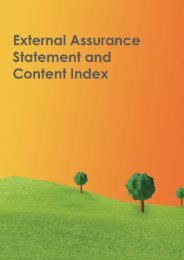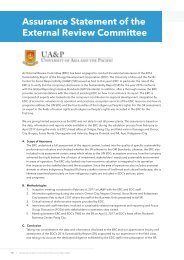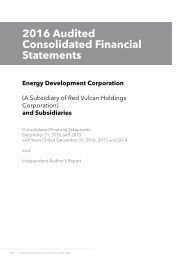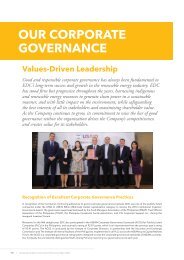2014 Financial Statement
Create successful ePaper yourself
Turn your PDF publications into a flip-book with our unique Google optimized e-Paper software.
EDC <strong>2014</strong> Performance Report<br />
Credit Quality of <strong>Financial</strong> Assets<br />
<strong>Financial</strong> assets are classified as high grade if the counterparties are not expected to default in<br />
settling their obligations. Thus, the credit risk exposure is minimal. These counterparties<br />
normally include customers, banks and related parties who pay on or before due date. <strong>Financial</strong><br />
assets are classified as a standard grade if the counterparties settle their obligation with the<br />
Company with tolerable delays. Low grade accounts are accounts, which have probability of<br />
impairment based on historical trend. These accounts show propensity of default in payment<br />
despite regular follow-up actions and extended payment terms.<br />
As of December 31, <strong>2014</strong> and 2013, financial assets categorized as neither past due nor impaired<br />
are viewed by management as high grade, considering the collectibility of the receivables and the<br />
credit history of the counterparties. Meanwhile, past due but not impaired financial assets are<br />
classified as standard grade.<br />
Foreign Currency Risk<br />
Foreign currency risk is the risk that the fair value or future cash flows of a financial instrument<br />
will fluctuate because of changes in foreign exchange rates.<br />
The Company’s exposure to foreign currency risk is mainly from the financial assets and liabilities<br />
that are denominated in US dollar (US$). This primarily arises from future payments of foreign<br />
currency-denominated loans and other commercial transactions and the Company’s investment in<br />
ROP Bonds.<br />
The Company’s exposure to foreign currency risk to some degree is mitigated by some provisions<br />
in the Company’s GRESCs, SSAs and PPAs. The service contracts allow full cost recovery while<br />
the sales contracts include billing adjustments covering the movements in Philippine peso and the<br />
US$ rates, US Price and Consumer Indices, and other inflation factors.<br />
To mitigate further the effects of foreign currency risk, the Company will prepay, refinance or<br />
hedge its foreign currency denominated loans, whenever deemed feasible. The Company also<br />
enters into derivative contracts to mitigate foreign currency risk.<br />
The Company’s foreign currency-denominated financial assets and liabilities (translated into<br />
Philippine peso) as of December 31, <strong>2014</strong>, and 2013, are as follows:<br />
Japanese<br />
yen (JP¥)<br />
Sweden<br />
kroner<br />
(SEK<br />
Original Currency<br />
Chilean<br />
Peso<br />
(CH₱)<br />
Peruvian<br />
Sol<br />
(PEN)<br />
<strong>2014</strong><br />
Singapore<br />
Dollar (SGD)<br />
New Zealand<br />
dollar (NZD)<br />
Peso<br />
Equivalent<br />
US$<br />
<strong>Financial</strong> Assets<br />
Loans and receivables:<br />
Cash equivalents 45,365,000 − − − − − − ₱2,028,722,800<br />
Cash on hand and in<br />
banks 7,115,870 − − 151,118,435 34,157 − − 329,890,847<br />
AFS investments:<br />
Debt investments 2,909,250 − − − − − − 130,101,660<br />
Derivative assets<br />
designated as cash<br />
flow hedges 3,447,432 − − − − − − 154,169,159<br />
Total financial assets 58,837,552 − − 151,118,435 34,157 − − ₱2,642,884,466<br />
(Forward)<br />
108
















